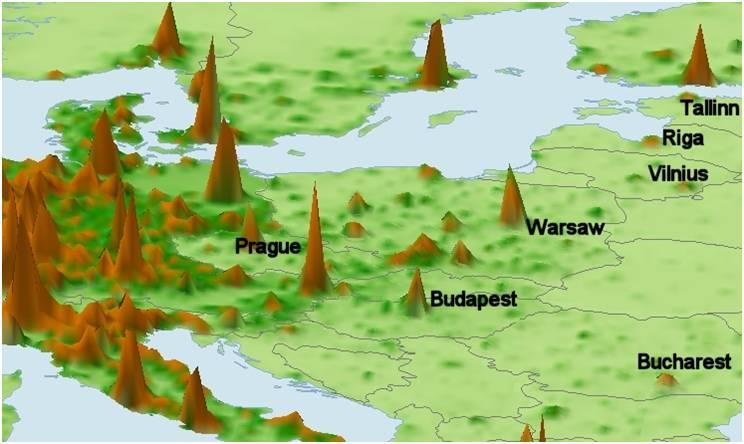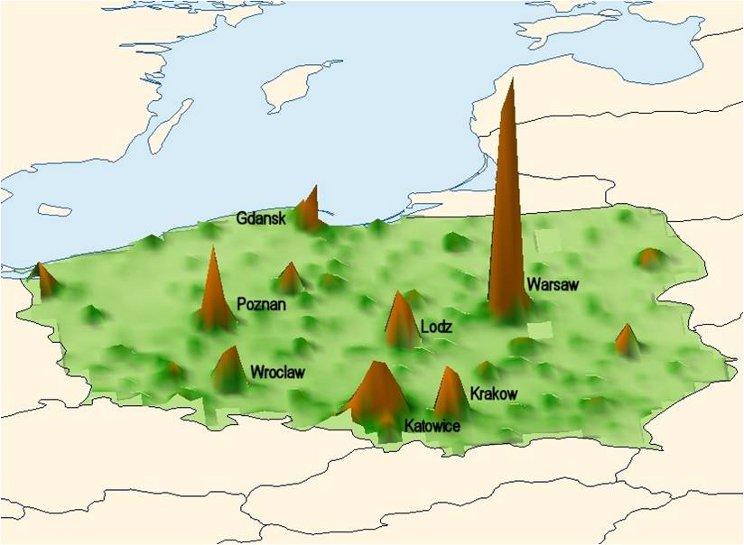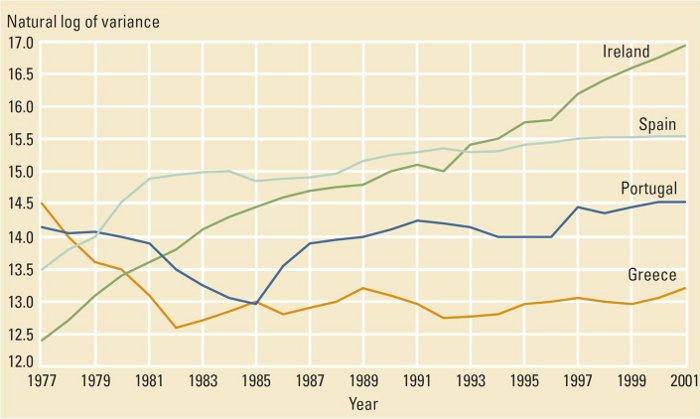Economic policy and economic geography are very much live issues, even if Paul Krugman (2010) suggested that the heyday of the New Economic Geography is past (Combes et al. 2008, Brülhart 2009).
2009 saw three major reports on the nexus:
- A report authored by Fabrizio Barca (2009) for the EU made the case for “tackling persistent underutilisation of potential and reducing persistent social exclusion in specific places through external interventions…”
- An OECD report (2009) argued that persistent disparities between regions imply unused growth potential, reckoning that since “per capita GDP in the top-ranked region of a[n OECD] country is at least double that of the lowest-ranked region”, it is better on efficiency and equity grounds for policies to target the lagging regions for growth-enhancing policies.
- The World Bank’s World Development Report Reshaping Economic Geography (2008) proposed policies that recognise the spatially unbalanced nature of economic growth.
Reality check: Economic growth will be unbalanced
The OECD and Barca reports are kind-hearted and well intentioned. But they do not face up to a fundamental fact. Prosperity does not come to every place at once, and to some places it does not come at all.
It is difficult for any caring person to accept this fact, but a quick look at any nation for any period since the industrial revolution confirms this. Policymakers, as responsible stewards of public money, must make policies based on clear-headed assessments of how growth and development actually take place. Any realistic analysis shows that economic activity is not evenly spread – definitely not in large middle-income countries such as Mexico, not in mid-sized but more developed countries such as Poland, nor even in small advanced economies such as Belgium.
Take a look at these two maps of economic density (GDP per sq km) in central Europe and a closer image of Poland’s economic geography (Figures 1 and 2). What these maps show is that at any geographic scale – global, regional, or national –economic activity is uneven, often spiky. And this pattern persists when countries attain high incomes. Economic density maps of Germany, France, Japan, and the US are also spiky.
Figure 1. Economic activity in central Europe – An uneven topography
Source: World Bank GIS Laboratory.
Figure 2. Economic activity in Poland – Unevenly distributed among places
Source: World Bank GIS Laboratory.
Old wine in new bottles
Regional development policies have tried to encourage – even coerce – enterprises to move away from the leading regions where economic activity has become concentrated, and locate in lagging regions. Over time, these policies have become somewhat more enlightened. Instead of discouraging enterprises from locating in leading areas, they now claim to encourage economic activity in lagging regions, to “exploit their unused potential.” This is a belated recognition of the power of economic concentration. Less charitable observers call these “new” place-based policies “old wine in new bottles”.
Integrate, integrate, integrate
This poses an apparent dilemma. Should policymakers abandon lagging regions, at least until a country accumulates so much wealth that it can waste some of it on incentives for economic activity in these places? The 2009 World Development Report provides a better solution. Policymakers should instead promote economic integration of lagging with leading places.
Even for those who have recognised the futility of providing economic incentives for staying and striving in lagging regions – such as the discouraged regional development specialists who worked for decades in Italy’s Mezzogiorno – the temptation is to think of highways, railroads, and airports as the main instrument of integration. The World Development Report emphasises that the most potent instruments for integration are spatially blind improvements in institutions; put more simply, the provision of essential services such as education, health, and public security. The OECD report acknowledges, “the positive impact of infrastructure investment on growth depends, for example, on education levels…”. But then it goes on to provide an obscure qualification: “The key appears to be how assets are used, how different stakeholders interact and how synergies are exploited in different types of regions.”
The World Development Report takes a clearer stand. Its main message is that economic growth will be unbalanced, and to try to spread out economic activity – too much, too far, or too soon – is to discourage it. But development can still be inclusive, in that even people who start their lives far away from economic opportunity can benefit from the growing concentration of economic activity in a few places. And the way to get both the benefits of uneven growth and inclusive development is through economic integration.
The notion of economic integration should be central to the debate on regional development, but the discussions have generally become narrowly focused on places that are not doing well. The World Development Report reframes this debate in a way that better conforms to the reality of development. The reality is that it is the interaction between leading and lagging places is the key to economic development. The reality is that spatially targeted interventions are just a small part of what governments can do to help places that are not doing well. The reality is that, besides place-based interventions, governments have far more potent instruments for integration. They can build the institutions that unify all places, and put in place infrastructure that connects some places to others.
The Report calls for rebalancing these policy discussions to include all the instruments of integration – institutions that unify, infrastructure that connects, and interventions that target. And it shows how to use the insights from centuries of experience and decades of analysis to tailor the use of these policy instruments to address integration challenges that range from the straightforward to the complicated (see Table 1).
Table 1. Regional development policies calibrated to integrate countries
|
|
Country type
|
|
|
Sparsely populated lagging regions
|
Densely populated lagging regions in united countries
|
Densely populated lagging regions in divided countries
|
|
What policies should facilitate
|
Labour and capital mobility
|
Labour and capital mobility
Market integration for goods and services
|
Labour and capital mobility
Market integration for goods and services
Selected economic activities in lagging regions
|
|
Policy Priorities
|
|
|
|
Spatially blind “institutions”
|
Fluid land and labour markets, security, education and health, safe water and sanitation
|
Fluid land and labour markets, security, education and health, safe water and sanitation
|
Fluid land and labour markets, security, education and health, safe water and sanitation
|
|
Spatially connective “infrastructure”
|
|
Interregional transport infrastructure
Information and communication services
|
Interregional transport infrastructure
Information and communication services
Local roads
|
|
Spatially targeted “incentives”
|
|
|
Incentives to agriculture and agro-based industry
Irrigation systems
Workforce training
|
Source: World Development Report 2009, Chapter 8.
The bedrock of regional development policies should be spatially blind provision of essential public services and balanced regulation of land, labour, and product markets. On this foundation of common institutions, well-chosen investments in connective infrastructure should be used to reduce the distance of people to prospering places. If history, language, or culture prevents people in lagging regions from accessing the economic opportunities in leading places, place-based economic incentives can help. But both logic and experience show that place-based incentives only succeed when they are accompanied by efforts to strengthen institutions and infrastructure.
Follow the Irish
The experience of Ireland is especially educational for the new and future member states of the EU. Between 1977 and 2008, Ireland’s GDP per capita grew from less than 75% of the EU average to more than 125%. Despite the crisis, Ireland remains among the ten countries with the highest per capita income in the world. What is behind Ireland’s success? Among other things, recognising the national benefits of spatial concentration, and coordinated efforts to promote domestic integration through a sensible blend of spatially blind social services and well-placed investments in infrastructure.
Since joining the EU in 1973, Ireland received approximately €17 billion in EU Structural and Cohesion Funds through the end of 2003. In the first two rounds of EU funding, the entire country was classified as an Objective One area. Between 1993 and 2003 cohesion funds supported 120 infrastructure projects at the cost of about €2 billion. The choice of projects was based on a national development plan, which focused on investments in economic infrastructure that stimulated national economic growth.
The Irish invested aggressively in education, training, and lifelong learning in all of Ireland to provide investors with a good business environment countrywide. Today, Ireland is one of the top ten countries for doing business. Infrastructure improvements were more selective. These included investments in leading regions and in connecting leading and lagging areas, such as the M50 (Dublin Ring Road), M1 (Dublin-Belfast), and improvements in the N4 (Dublin-Sligo), N7 (Dublin- Limerick), and N11 (Dublin-Rosslare). With its skilled labour force and good logistics, Ireland has become a popular destination for American firms wishing to reach European markets, and a popular destination for European workers.
Contrast the Irish approach to cohesion funds with the “Iberian approach”. Ireland’s rapid convergence toward the incomes of Europe’s leaders was accompanied by a rising spatial concentration of economic activity. Compared with the other cohesion countries – Greece, Portugal, and Spain – Ireland’s economic concentration rose much more (see the Figure 3 below). But its per capita income grew much faster too. In 1977 Greece, Ireland, and Spain had per capita incomes of about $9,000; Portugal’s was about $6,000. By 2002 Portugal had an income of $11,000, and Greece and Spain close to $15,000. Ireland’s per capita income had risen to $27,500. By 2008, it was more than $45,000, among the highest in the EU.
Figure 3. As Ireland converged internationally, domestic concentration increased
Sources: Dall’Erba (2003) and World Bank (2008)
Today, almost all regions in the new member nations in Eastern Europe qualify for EU financial support. They should consider the Irish example of using the funds for international convergence and not – until later stages – for spatially balanced economic growth within their borders. As the old member states of Western Europe struggle to find new drivers of growth and greater efficiency in public spending, they too would do well to shift from place-based incentives to people-centred policies that help harness the benefits of agglomeration, mobility, and specialisation.
References
Barca, Fabrizio (2009), An Agenda for a Reformed Cohesion Policy: A Place Based Approach to Meeting European Union Challenges and Expectations, Brussels.
Brülhart, Marius (2009), “Is the new economic geography passé?”, VoxEU.org, 7 January.
Combes, Pierre-Philippe, Miren Lafourcade, Jacques-François Thisse, Jean-Claude Toutain (2008), “Long-run spatial inequality in France: Evolution and determinants”, VoxEU.org, 5 December.
Dall'Erba, Sandy (2003), "The Efficiency-Equity Trade-off as an Explanation of the Mitigated Success of the European Regional Development Policies", University of Illinois Working Paper. Urbana, IL.
Krugman, Paul (2010), “The new economic geography, now middle-aged”, Presentation for the Association of American Geographers, 16 April.
OECD (2009), Regions Matter: Economic Recovery, Innovation and Sustainable Growth. Paris.
World Bank (2008), World Development Report 2009: Reshaping Economic Geography, Washington, DC .






